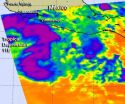(Press-News.org) EVANSTON, Ill. --- When mercury is dumped into rivers and lakes, the toxic heavy metal can end up in the fish we eat and the water we drink. To help protect consumers from the diseases and conditions associated with mercury, researchers at Northwestern University in collaboration with colleagues at Ecole Polytechnique Fédérale de Lausanne (EPFL) in Switzerland, have developed a nanoparticle system that is sensitive enough to detect even the smallest levels of heavy metals in our water and fish.
The research was published September 9 in the journal Nature Materials.
"The system currently being used to test for mercury and its very toxic derivative, methyl mercury, is a time-intensive process that costs millions of dollars and can only detect quantities at already toxic levels," said Bartosz Grzybowski, lead author of the study. "Ours can detect very small amounts, over million times smaller than the state-of-the-art current methods. This is important because if you drink polluted water with low levels of mercury every day, it could add up and possibly lead to diseases later on. With this system consumers would one day have the ability to test their home tap water for toxic metals."
Grzybowski is the Kenneth Burgess Professor of Physical Chemistry and Chemical Systems Engineering in the Weinberg College of Arts and Sciences and the McCormick School of Engineering and Applied Science.
The new system is comprised of a commercial strip of glass covered with a film of "hairy" nanoparticles, a kind of a "nano-velcro," that can be dipped into water. When a metal cation --- a positively charged entity, such as a methyl mercury --- gets in between two hairs, the hairs close up, trapping the pollutant and rendering the film electrically conductive.
A voltage-measuring device reveals the result; the more ions there are trapped in the "nano-velcro," the more electricity it will conduct. To calculate the number of trapped particles, all one needs to do is measure the voltage across the nanostructure film. By varying the length of the nano-hairs covering the individual particles in the film, the scientists can target a particular kind of pollutant that is captured selectively. With longer "hairs," the films trap methyl mercury, shorter ones are selective to cadmium. Other metals also can be selected with appropriate molecular modifications.
The nanoparticle films cost somewhere between $1 to $10 to make, and the device to measure the currents costs a few hundred dollars, Grzybowski said. The analysis can be done in the field so the results are immediately available.
Researchers were particularly interested in detecting mercury because its most common form, methyl mercury, accumulates as one goes up the food chain, reaching its highest levels in large predatory fish such as tuna and swordfish. In the United States, France and Canada, public health authorities advise pregnant women to limit fish consumption because mercury can compromise nervous system development in the fetus.
Researchers used this system to detect levels of mercury in water from Lake Michigan, near Chicago, among other samples. Despite the high level of industry in the region, the mercury levels were extremely low.
"The goal was to compare our measurements to FDA measurements done using conventional methods," said Francesco Stellacci of EPFL, co-corresponding author of the study. "Our results fell within an acceptable range."
The researchers also tested a mosquito fish from the Florida Everglades, which is not high on the food chain and thus does not accumulate high levels of mercury in its tissues. The U.S. Geological Survey reported near-identical results after analyzing the same sample.
"This technology provides an inexpensive and practical alternative to the existing cumbersome techniques that are being utilized today," said Jiwon Kim, graduate student in Grzybowski's lab in the department of chemistry at Northwestern. "I went to Lake Michigan with our sensor and a hand-held electrometer and took measurements on-site in less than a minute. This direct measurement technique is a dream come true for monitoring toxic substances."
INFORMATION:
Mercury in water, fish detected with nanotechnology
Inexpensive, super-sensitive device detects even low levels of toxic metals in water, fish
2012-09-13
ELSE PRESS RELEASES FROM THIS DATE:
HF/E researchers examine older adults' willingness to accept help from robots
2012-09-13
Most older adults prefer to maintain their independence and remain in their own homes as they age, and robotic technology can help make this a reality. Robots can assist with a variety of everyday living tasks, but limited research exists on seniors' attitudes toward and acceptance of robots as caregivers and aides. Human factors/ergonomics researchers investigated older adults' willingness to receive robot assistance that allows them to age in place, and will present their findings at the upcoming HFES 56th Annual Meeting in Boston.
Changes that occur with aging can ...
BYU study: Exercise may affect food motivation
2012-09-13
It is commonly assumed that you can "work up an appetite" with a vigorous workout. Turns out that theory may not be completely accurate – at least immediately following exercise.
New research out of BYU shows that 45 minutes of moderate-to-vigorous exercise in the morning actually reduces a person's motivation for food.
Professors James LeCheminant and Michael Larson measured the neural activity of 35 women while they viewed food images, both following a morning of exercise and a morning without exercise. They found their attentional response to the food pictures decreased ...
Feeding microbials to chickens leads to mysterious immune response
2012-09-13
A paper recently published in the Journal of Animal Science helps researchers further understand how microbials and probiotics affect poultry health.
Researchers at the North Carolina State University and Chung Jen College of Nursing, Health Sciences and Management (Taiwan) conducted a study to investigate the effects of direct fed microbials on energy metabolism in different tissues of broiler chickens. The researchers wanted to learn how consuming microbials and probiotics could change energy use and immune function. Typically, direct fed microbials and probiotics are ...
Hopkins scientists discover how an out-of-tune protein leads to muscle demise in heart failure
2012-09-13
A new Johns Hopkins study has unraveled the changes in a key cardiac protein that can lead to heart muscle malfunction and precipitate heart failure.
Troponin I, found exclusively in heart muscle, is already used as the gold-standard marker in blood tests to diagnose heart attacks, but the new findings reveal why and how the same protein is also altered in heart failure. Scientists have known for a while that several heart proteins — troponin I is one of them — get "out of tune" in patients with heart failure, but up until now, the precise origin of the "bad notes" remained ...
Smoking abstinence tough for teens, too
2012-09-13
Abstinence from smoking seems to affect teens differently than adults in a couple ways, but a new study provides evidence that most of the psychological difficulties of quitting are as strong for relatively new, young smokers as they are for adults who have been smoking much longer.
"Adolescents are showing — even relatively early in the dependence process — significant, strong, negative effects just after acute abstinence from smoking," said L. Cinnamon Bidwell, assistant professor (research) in psychiatry and human behavior and the Center for Alcohol and Addiction Studies. ...
NASA Global Hawk and satellites attend Tropical Storm Nadine's 'Birth'
2012-09-13
Tropical Depression 14 strengthened into Tropical Storm Nadine while NASA's Hurricane Severe Storm Sentinel Mission, or HS3 mission, was in full-swing and NASA's Global Hawk aircraft captured the event. While the Global Hawk was gathering data over the storm, NASA satellites were also analyzing Nadine from space.
NASA's Global Hawk landed back at Wallops Flight Facility, Wallops Island, Va., after spending a full day gathering data from the 14th Atlantic Tropical Depression that strengthened into Tropical Storm Nadine during the morning hours of Sept. 12.
The Global ...
NASA gives infrared identification of new Eastern Pacific Tropical Depression
2012-09-13
One of NASA's infrared "eyes" is an instrument that flies aboard the Aqua satellite, and it provided data that helped forecasters determine that low pressure "System 90E" strengthened into the eastern Pacific Ocean's eleventh tropical depression.
The Atmospheric Infrared Sounder (AIRS) instrument onboard Aqua captured an infrared image of System 90E on Sept. 11 at 1947 UTC (3:47 p.m. EDT). That infrared image took the temperatures of the cloud tops and found some strong, high thunderstorms wrapped around the western side of the low pressure area's circulation, from north ...
Gestational exposure to urban air pollution linked to vitamin D deficiency in newborns
2012-09-13
Chevy Chase, MD—Gestational exposure to ambient urban air pollution, especially during late pregnancy, may contribute to lower vitamin D levels in offspring, according to a recent study accepted for publication in The Endocrine Society's Journal of Clinical Endocrinology and Metabolism (JCEM). According to study authors, this could affect the child's risk of developing diseases later in life.
Recent data have demonstrated that maternal vitamin D deficiency during pregnancy may have an influence on the development of asthma and allergic diseases in offspring. A number ...
Puberty turned on by brain during deep sleep
2012-09-13
Chevy Chase, MD—Slow-wave sleep, or 'deep sleep', is intimately involved in the complex control of the onset of puberty, according to a recent study accepted for publication in The Endocrine Society's Journal of Clinical Endocrinology and Metabolism (JCEM).
The many changes that occur in boys and girls during puberty are triggered by changes in the brain. Previous studies have shown that the parts of the brain that control puberty first become active during sleep, but the present study shows that it is deep sleep, rather than sleep in general, that is associated with ...
Mild increases in thyroid-stimulating hormone not harmful in the elderly
2012-09-13
Chevy Chase, MD—There is no evidence to link mildly elevated thyroid-stimulating hormone (TSH) levels to an increase in mortality among the elderly, according to a recent study accepted for publication in The Endocrine Society's Journal of Clinical Endocrinology & Metabolism (JCEM). The findings suggest that reflexively treating mild elevations of TSH in those of advanced age is unnecessary.
TSH is a sensitive, commonly measured test to check thyroid function. TSH levels are inversely related to thyroid hormone levels – thyroid hormone levels below a set-point trigger ...
LAST 30 PRESS RELEASES:
Bharat Innovates 2026 National Basecamp Showcases India’s Most Promising Deep-Tech Ventures
Here’s what determines whether your income level rises or falls
SCIE indexation achievement: Celebrate with Space: Science & Technology
Children’s Hospital Colorado performs region’s first pediatric heart and liver dual organ transplant
Australian team discover why quantum computers have memory problems over time
What determines the fate of a T cell?
Candida auris: genetic process revealed which could be treatment target for deadly fungal disease
Groundbreaking discovery turns household plastic recycling into anti-cancer medication
Blocking a key inflammatory pathway improves liver structure and vascular function in cirrhosis, study finds
Continuous spread: Raccoon roundworm detected in nine European countries
HKUST Engineering researchers developed a novel photodetector to enhance the performance of on-chip light monitoring
Strategic river sensors could have forewarned of Texas Camp flood disaster
Drone sampling of whale breath reveals first evidence of potentially deadly virus in Arctic
Roman soldiers defending Hadrian’s Wall infected by parasites, study finds
Pinochet’s prisoners were tormented with music but still found solace in it, a new book reveals
Fertility remains high in rural Tanzania despite access to family planning
AI-assisted device can improve autism care access
Kinetic careers
Uncovering how parasitic plants avoid attacking themselves to improve crop resistance
Nanoparticle vaccine strategy could protect against Ebola and other deadly filoviruses
Study finds brain care score can predict risk of stroke across racial groups
Key lung immune cells can intensify allergic reactions
Do hormones explain why women experience more gut pain?
New materials conduct ions in solids as easily as in liquids
Breakthrough of the Year: Renewable energy begins to eclipse fossil fuel-based sources
LLM use is reshaping scientific enterprise by increasing output, reducing quality and more
Introducing LightGen, a chip for ultra-fast, ultra-efficient generative AI
Astronomers see fireworks from violent collisions around nearby star
ACC/AHA issue new guideline on managing congenital heart disease in adults
Cosmic crash caught on camera
[Press-News.org] Mercury in water, fish detected with nanotechnologyInexpensive, super-sensitive device detects even low levels of toxic metals in water, fish



